

When you do UWorld, do you read through the question explanation as if your life depended on it? Do you hang on every word, willing yourself to learn every single word?
Most importantly, much do you remember the next day? The truth is, you probably forget most of what you’re reading in UWorld.
If you’re someone who:
- Scrutinizes UWorld explanations but still gets related questions wrong
- Forgets most of what they’re learning from QBanks, and/or
- Is drowning in flashcards
Then this article is for you!
In this article, you’ll learn how to:
- Focus on the essential aspects of UWorld, so you stop being overwhelmed
- Make useful Anki cards, so you don’t drown in flashcards
- Learn fact-based topics like pharmacology and microbiology
Here are five ways to improve your UWorld scores by using Anki effectively.
(To read UWorld: Is Your Strategy Wrong? (I Scored 270 By Ignoring The Dogma), click here).
Table of Contents
1. Don’t Make More Cards Than You Can Review
When you start using Anki, you feel like anything is possible. You can remember anything, forever. Many students respond by putting every single fact into their Anki cards.
However, making so many new cards has downsides.
Generally, I recommend doing at most 50-60 new cards/day. If you make more cards than you do, unreviewed cards will accumulate. In other words, if I make 80 cards a day, but only review 50 new cards in my deck, a net of 30 cards will build every day. This causes multiple problems, including:
- Wasting hours on cards that won’t help you get USMLE questions correct
- Diluting the useful cards
(To read Basic Anki Card Creation: The Complete Guide for Med School and the USMLE Step Exams, click here).
2. Use the “Educational Objective” to Prioritize the Most Important Information
I know what you’re thinking. “But there is SO MUCH information to put into Anki cards. How could I limit myself to only making 40-50 questions a day?”
Because putting everything into Anki cards is a fools’ errand. Why? By making too many flashcards, you’ll spend all day on Anki. You won’t be able to do UWorld or any other QBank.
There is a ton of information that is found in the question explanations that MIGHT be useful. It is tempting to put every single fact you don’t know into Anki cards.
Here are some examples of things you’ll be tempted to turn into cards, but shouldn’t:
- Might it be useful to memorize the prevalence of osteoporosis in 60-year-olds in the US? Sure, there is a slim chance this fact could help you.
- Could I get a question right by knowing the time-course of symptoms in measles? Absolutely, anything is possible. But is it likely knowing this factoid will help you? Doubtful.
Don’t Ask, “Could This Information Be Useful?” Ask, “Is This Information Worth the Opportunity Cost?
Literally, any fact MIGHT be useful on your test or your future clinical practice. However, that’s the wrong question to ask. Every action has a cost, and spending all day on Anki means you won’t be able to do other things.
Instead, whenever you make a card, ask yourself, “Will this card be MORE useful than:
- Mastering a new topic, or
- Doing QBank questions?”
Often, the answer will be “no.”
I’ve seen plenty of students fall into the trap of, “well, if 10 Anki cards on this subject are good, then 100 must be better!”
Instead, focus on information that is in the educational objective/ReKaps, or that is in First Aid. There’s a reason why most QBanks have an “Educational Objective” for each question. There is a hierarchy of useful information. Trying to learn the entire pyramid will cause your NBME scores to stagnate.
(To read How to Ensure Your USMLE Studying is “High Yield”, click here).
3. Linking a Disease’s Pathogenesis to Presentation → Fewer, Better Cards
The NBME, writers of the USMLEs, is very clear about their goals. To do well on the USMLEs, you need to use knowledge. Memorizing disconnected facts will lead to low USMLE scores.
But how do you practically master material, especially if you’ve crammed for most of your life? The best place is to make connections.
For each disease you learn, ask three simple questions:
- What is the pathogenesis?
- What is the presentation?
- How can I connect the two?
For example,
- Don’t ask: “What is the translocation seen in Burkitt’s lymphoma?”
- Instead, ask: “What is the translocation seen in Burkitt’s lymphoma, and how does that explain its presentation and response to chemotherapy?”
If you struggle to make these connections yourself, check out the Yousmle Step 1 cards. In it, you’ll find pre-made cards targetting students’ most significant gaps. You can master more in less time and maximize your USMLE score.
Similarly, if you watch lectures but forget them immediately, check out the Yousmle Online Course. Not only will you make connections, but with the integration/application questions you’ll never forget another lecture again.
Check out the Yousmle Online Course here.
Making Connections Creates Fewer Cards
The more connections you make, the fewer cards you will have to make. For example, most people make tons of cards to learn a topic like “epidural hematoma.” They’ll memorize the:
- Presentation: faster presentation, over hours rather than days/weeks
- Pathogenesis: the rupture of the middle meningeal artery
- Susceptible population: patients with focal trauma
Each of these facts would require 1-2 cards, making at least 3-6 cards for a single subject. Instead, what if I connected the different points:
Pathogenesis to presentation to susceptible population: the middle meningeal artery arises from beneath the pterion, a very specific location. Thus, epidural hematomas often occur in patients with focal trauma. Plus, because arteries have much higher pressure than veins, blood will accumulate more quickly than in a subdural hematoma. Thus, the presentation will be on a shorter time-frame than for subdural hematomas.
Since I can connect those facts, I only need a single card.
But isn’t there too much information on that card? There may seem like a lot of information on this card. However, because it is all connected, I can still remember it. (I’ll likely remember it even better than disconnected, random facts).
Having a better understanding leads to fewer, more useful cards. There no substitute for real knowledge. Also, knowing the “why’s” and “how’s” will cut down your review time drastically.
(To read UWorld + First Aid: 4 Keys to Mastery (#4 Bumped Me to 270 from 236), click here).

Making connections gives you better understanding, saves time on Anki reviews.
4. Compare and Contrast Subjects to Reduce Cards, Improve Recall
Want to make even fewer cards, and improve your recall on your exam? Make cards that compare and contrast related topics.
Without comparing/contrasting with related topics, our card would look like this:
Front:
Epidural hematoma – how can you use the pathogenesis to explain how quickly it would present?
Back:
Middle meningeal artery rupture. Arteries have ↑ pressure → faster bleed → faster presentation.

Studying each disease individually is slow.
However, by relating epidural and subdural hematomas, I could write one like this:
Front:
Epidural vs. subdural hematoma – how can you use the pathogenesis to explain how quickly it would present?
Back:
Middle meningeal artery rupture. Arteries have ↑ pressure → faster bleed → faster presentation (hours)
Bridging vein rupture. Venous < arterial pressure → slower build-up → slower progression (days to weeks)

Comparing/contrasting related diseases improves recall and saves time.
Comparing and contrasting cards help you with retention/recall of knowledge. It also reduces the number of flashcards you have to make. Stop making a set of cards for one disease, then another set of cards for a related illness. Instead, combine the two by comparing/contrasting some aspect of the conditions.
For more tips on Anki card making, see my guide to basic Anki card-making, as well as more advanced tips to supercharge your Anki cards.
5. Make a Pharmacology Deck
Generally, you should try to minimize the number of cards you make. However, the exception to this rule is when you need to memorize lots of details.
The best example of a subject with lots of details to memorize is pharmacology. For each drug, you should know the:
- Mechanism,
- Adverse effects, and
- Use
Plus, you should know the information forwards and backward. In other words, you should know that statins block HMG-CoA reductase. However, you should also have a card testing you on the reverse, as well. (“What drugs block HMG-CoA Reductase? Statins.)
In Anki-speak, you would make double-sided cards to test yourself in both directions. If you’re doing the math, you should make 6 cards/drug. 6 cards for each drug adds up quickly. Thus, I recommend making a separate deck for pharmacology. (Making a distinct microbiology deck is an additional option).
(To read How to Master Pharmacology for the USMLE Step 1 Over a Glass of Wine, click here).
Overwhelmed with how to master pharmacology in a short period of time? If you want to improve your pharmacology score in the least amount of time, use the Yousmle Pharmacology Deck. It has all the critical information for each commonly-tested drug. Plus, because I’ve connected much of the information for you, you’ll be able to use it better on your test.
Concluding Thoughts
We often feel that learning everything in UWorld is our best option. However, trying to cram every detail into your head is a waste of time. Using Anki to memorize everything can only make it worse.
In the short-term, it’s harder to master something. You may be tempted to say, “I don’t have time to learn anything well.” However, over time, understanding material is faster and leads to higher scores. You won’t have to repeat information. Plus, mastery leads to fewer, better cards.
If you aren’t sure where to start, check out the Yousmle Step 1 Cards. You can master material faster, and never forget it so you can improve your scores without wasting time.
Is learning every word of UWorld a struggle? Have you ever tried using Anki to do so? Let us know about your experience in the comments!
Photo by Clint Adair.








Hey Alec. Probably this is a common question but I can’t find a straight forward answer. I want to get the “Yousmle Step 1 Deck” of Anki. I’m planning to prepare for 6 months. 1. How many new Anki cards should I learn everyday and how many old ones should i review in a daily basis??
I am an IMG who is going to be starting my 3rd year of med. school. I haven’t taken any steps, and haven’t begun preparing, or reviewing any anki cards. Would it be a good idea to start reviewing the decks for step 1 from my 3rd year?
Hi! Great question. Doing well on Step 1 requires a large, strong base of knowledge, which must be acquired over a long period of time. As such, starting as early as possible, is good, so that when you get to your dedicated studying at some point, you will know the majority of the information, and can work on fine-tuning things, rather than having to learn everything from the beginning.
Alec
I recently purchased the Anki deck last week and had a quick exchange with Alec about the contents. For anyone interested here is a quick synopsis of the conversation to shed some light on the deck:
The deck currently has a total of 1682 cards spanning all of the sections. If you download it, you will notice there are 55 cardiology cards total. In the cardio starter/sample deck, there are 131 total cards devoted to cardiology with 64 cards that are under the category yousmle step 1 sample. This means that it is helpful to try and download all the sample decks available on the site since there are more cards. With this, it is also important to note that the deck serves as a way to ensure users know the topics Alec has seen to be the trickiest, and serves as an example of how to make cards properly. Once you have seen the deck and understand the thought process behind cards, you can keep on adding cards to the deck for topics that you specifically need to work on. This helps keep the deck brief, and allows each user to individualize the deck towards their specific needs.